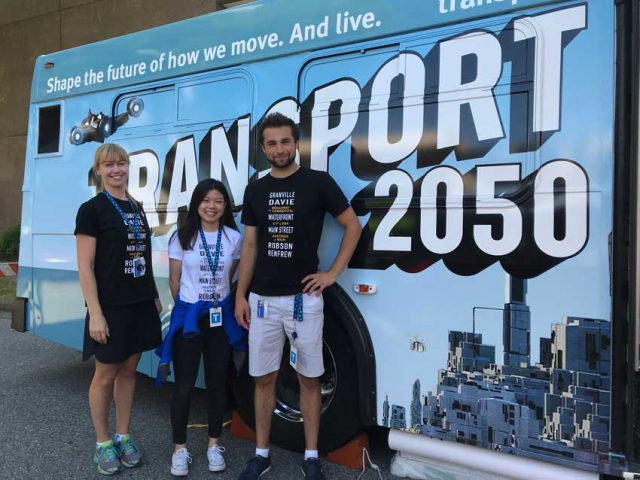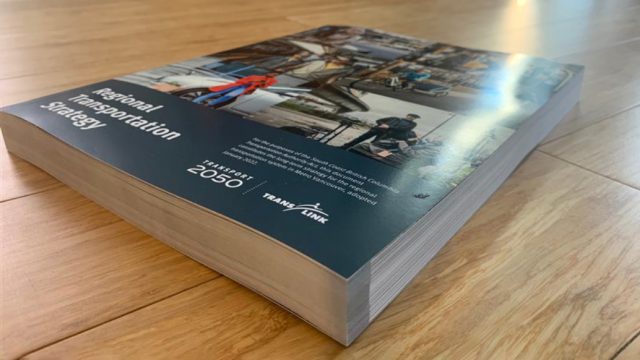Transport 2050: the future of transportation in Metro Vancouver starts now
Transport 2050: the future of transportation in Metro Vancouver starts now
We had three big questions for Metro Vancouver residents when it came to our region’s new 30-year transportation strategy. What do you value most about where you live? What are your transportation priorities? And what are your ideas for the future of transportation? No idea was too big — or too small. And you responded in a big way, making it the largest public engagements in TransLink’s history.
We’ve turned your ideas into Transport 2050, the region’s new 30-year transportation strategy. The Mayors’ Council on Regional Transportation and the TransLink Board of Directors adopted it this week, setting the stage for new major investments and policies.
What’s in the plan?
Transport 2050, the new Regional Transportation Strategy, responds to residents’ top priorities, such as climate change and affordability, and will create more transportation options for everyone. We heard throughout engagement that expanding and improving Metro Vancouver’s transit system was a top priority for residents regardless of whether they drive, cycle, or take transit.
The strategy identifies more than 100 actions to improve transportation:
- Quadrupling the size of the rapid transit network, from 100 to 400 kilometres
- Building out an 850-kilometre traffic-protected major bikeway network
- Dedicating more streets to walking, biking, rolling, and transit
- Putting frequent transit within a short walk of most homes and jobs
- Promoting electrified and shared bikes, scooters, and cars
Thank you!

Transport 2050 was built from TransLink’s largest-ever public engagement. We had over 160,000 conversations with the public and engaged over 500 stakeholder groups through 360 in-person or virtual events across 27 municipalities. There were more than 38,000 survey responses, more than 4,000 ideas.
When we asked the region to think big during Phase 1 of public engagement in 2019, ideas ran the gamut.
Pete said we should allocate more space for parks and shared transportation. Another from “Mark IV” dreamed up a future where there would be more bus lanes. “DavidInSurrey” wanted transit as fast as or competitive with driving. “ASL” and “ogopogo13” were among the idea submitters that wanted improved long-distance express services to outside the Metro Vancouver region. “Mundar” said highways shouldn’t be the “backbone of travelling” in the region.
These are the many ideas that were captured and reflected in Transport 2050 that includes more than 100 actions. One key action is the Reliable & Fast Transit Network. It would be fast and competitive with cars as “DavidInSurrey” ideated and includes “ASL” and “ogopogo13’s” desire for new express or interregional connections. There would be more bus lanes as “Mark IV” suggested with hundreds of kilometres of new rapid transit delivered mostly at street level through bus-rapid transit.
At the more local level, Transport 2050 envisions frequent local transit service within a five-minute walk of nearly all communities within the urban parts of the region. This will help make transit the preferred choice to move around in the region, reducing our reliance on highways as suggested by “Mundar.”
Transport 2050 also includes actions towards dedicating more streets to walking, biking, rolling and transit.
This includes an 850-kilometre Major Bikeway Network and a vision for complete traffic-protected bike networks in every urban centre in Metro Vancouver. We’ll also promote electric and shared vehicles: bikes, scooters, and cars. These actions respond to Pete’s idea submission.
These are just some examples of how we’re delivering a Regional Transportation Strategy that people strongly support. Through a 2,000-respondent survey and 553-respondent representative panel, about 75 per cent of people said they support the strategy and approximately 80 per cent support the proposed rapid transit expansion.
A strong history
Metro Vancouver consistently ranks among the world’s most livable places. They even have a term for us! Vancouverism. It’s an honour that didn’t happen haphazardly, but rather something we earned and achieved together through smart regional planning.
Planners first envisioned the region as “cities in a sea of green.” Then came Transport 2021, which was a regional transportation strategy like Transport 2050. Next, Metro Vancouver created the Livable Region Strategic Plan to manage growth our region. Together these two plans have shaped the region and its impact continues to reverberate today.
When we complete the final phase of the 10-Year Vision, Metro Vancouver’s transportation current expansion plan, we will have built out nearly the entire road and transit system that was envisioned three decades ago in Transport 2021. The priority for the Millennium Line, Canada Line, the Evergreen, Broadway Subway, Surrey Langley SkyTrain extensions, as well as the RapidBus network were all laid out in this plan.
Our new regional transportation strategy, Transport 2050, will have the same transformative effect on our region as Transport 2021.
What’s next?
We’re working on a detailed implementation blueprint so that we can get started right away on bringing transportation improvements to the region.
Thanks to everyone who shared their vision and ideas. To see how Transport 2050 will shape the future of how we move and live, visit transport2050.ca.







where can I pick up a paper copy of this plan?